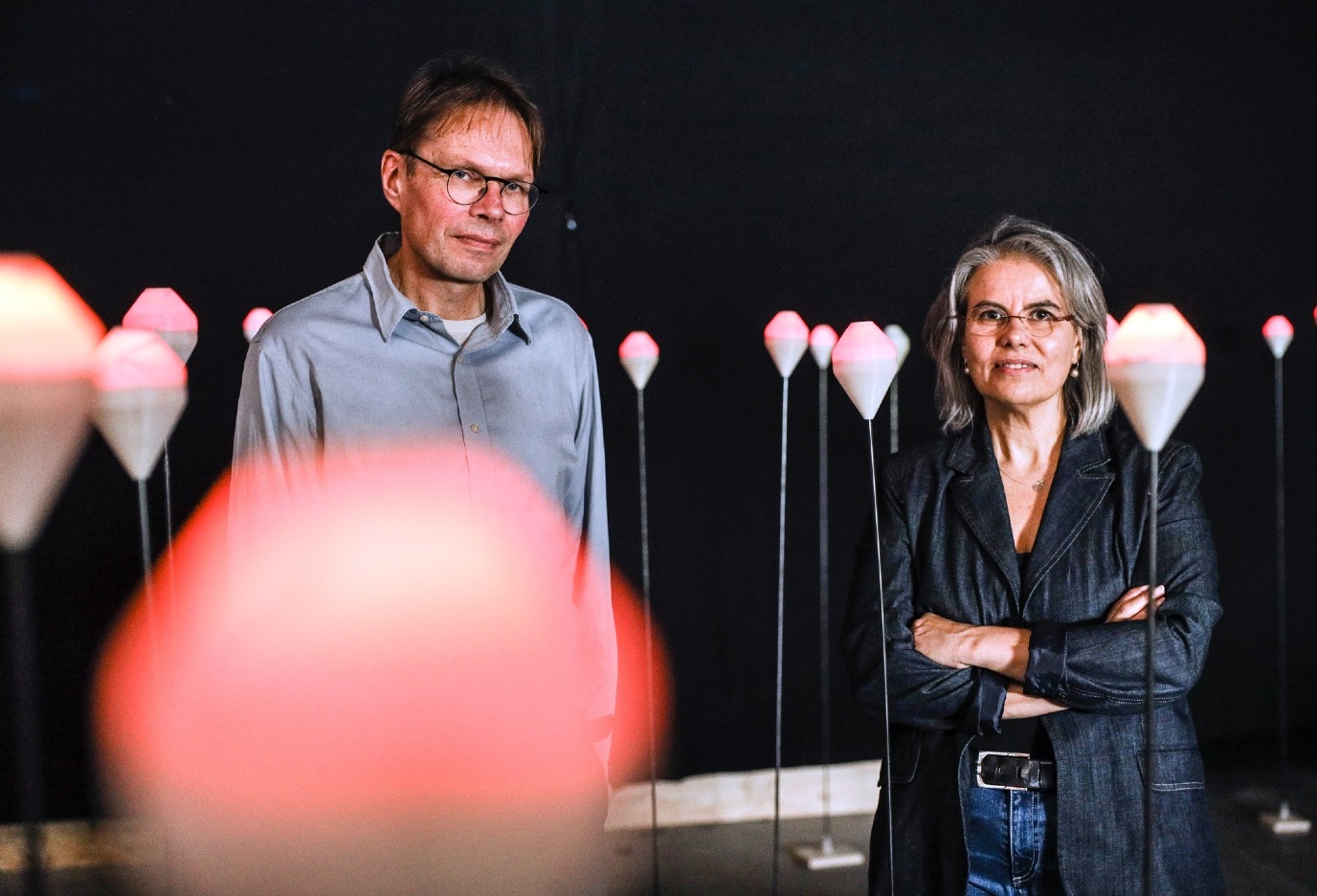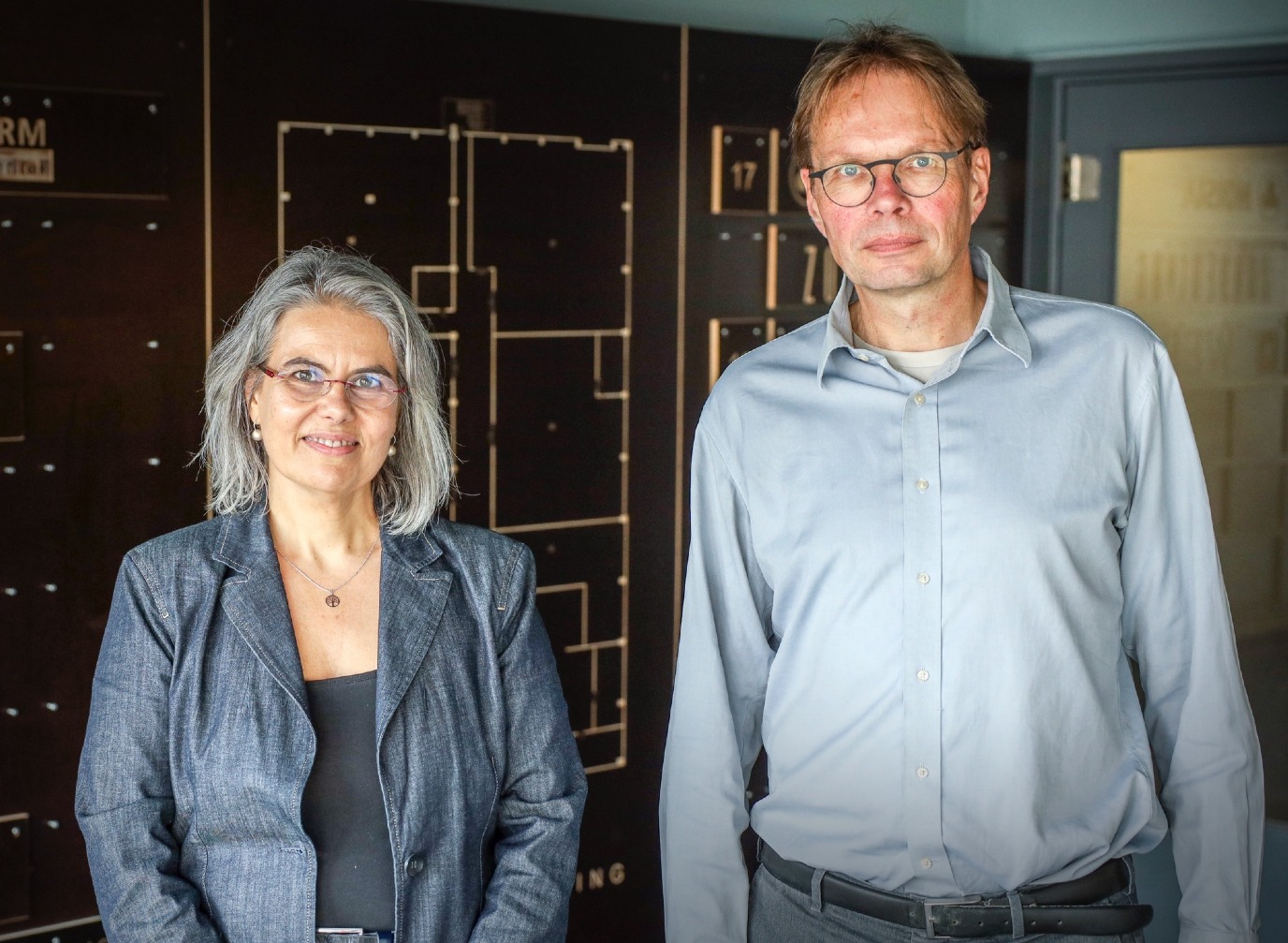CogniGron: A revolution in future-proof computing
As a society, we are nearing the physical limits of improving digital computers. In order to keep developing them, we need to find other ways of computing. The Groningen Cognitive Systems and Materials Center (CogniGron) of the University of Groningen (UG) is at the forefront of this revolution, focusing on neuromorphic computing. In this first article of the two-part CogniGron series, Beatriz Noheda, Niels Taatgen, and Erika Covi tell us about drawing inspiration from the human brain to make smart devices even smarter.
Text: Maud Brongers / Photos: Henk Veenstra
Did you know that the human brain uses only approximately 20 watts? Nowadays, our computers are also capable of performing human-like tasks, such as image, sound, or text recognition, but they require 20,000 watts to do so. As such, our brain is a great source of inspiration, both for finding solutions to the huge energy demands of current data centres and for using the evolutionarily optimized brain principles in the design of smart devices. At CogniGron, researchers in material science, artificial intelligence, mathematics, and computer science from all over the world are joining forces to educate a new generation of scientists and develop a computer chip that is 10,000 times more energy-efficient than current computers.

Mimicking the architecture of the brain
Neuromorphic computing, inspired by the way the human brain processes information, offers significant advantages over traditional digital computers, particularly in terms of energy efficiency, latency, and in some applications, even privacy. Prof. Beatriz Noheda, Scientific Director of CogniGron, highlights that the co-localization of memory and processing information in the brain is a key feature that reduces energy consumption. Traditional computers consume most of their energy through data transport; a problem the architecture of the brain naturally avoids.
Prof. Niels Taatgen is Professor of Cognitive Modeling in the Department of Artificial Intelligence at the University of Groningen. At CogniGron, he works on AI systems. Taatgen explains that neural networks have revolutionized AI due to their efficiency and superior performance over other machine learning techniques. These networks operate similar to brain cells by clustering incoming signals and transmitting them when a threshold is reached. Taatgen adds that classical computer architecture is based on a mathematical fundament that is now more than seventy years old. However, this may not be sufficient for neuromorphic computing, which requires a new theoretical framework drawing on various disciplines.
At CogniGron, researchers are exploring new electronic components and algorithms that can adjust neural connections locally, rather than relying on current global systems. This research is part of a broader effort to design a new type of computer architecture that is both energy-efficient and capable of handling AI tasks effectively.

Improving the quality of life
Taatgen explains that neuromorphic computing is a promising new development in computer science, alongside quantum computing. Because the world’s energy sources are limited and it is becoming increasingly difficult to make computer chips smaller, we need to build our computers differently. He describes how the energy efficiency and privacy aspects of neuromorphic computing will benefit society. One way to protect privacy is to keep your data on your device. Currently, we rely on cloud servers located in data centres all over the world, but this new technology will render the data centres redundant and the data will remain on your device’. ‘This way, people will gain more control over their own technological devices and privacy since their data is no longer shared with big companies,’ Taatgen says.
However, privacy is by no means the only field of application. Assistant professor of Cognitive Devices Dr Erika Covi describes possible applications for CogniGron’s work in medicine and robotics. One medical example can be found in pacemakers used to treat cardiac arrhythmia. Covi explains that patients need to visit the doctor every six months to calibrate the pacemaker. This is not because of the hardware, but because people age. Their biological signature changes, and the pacemaker cannot adapt. ‘If we have an intelligent system that is able to recognize and adapt to this change by detecting abnormalities and determining when it should start working, the patient will only need to visit the doctor once every one or two years. This will benefit both the patient and the doctor,’ Covi says. Furthermore, medical devices with neuromorphic features could also improve life expectancy by detecting the early stages of a disease.

Developing a common language
CogniGron distinguishes itself in the field of neuromorphic computing by its multidisciplinary approach. Noheda illustrates this unique collaboration: ‘With such a challenging set of problems we are researching within CogniGron, we need the absolute best scientists from each field. We aim to tackle cutting-edge challenges in each field while ensuring that by overcoming these problems we are contributing to solving the broader challenges that CogniGron is working on. However, this is very tricky if a mathematician, for example, does not know anything about computer science or AI.’
CogniGron has found an appropriate solution by having parallel PhD projects supervised by scientists from different disciplines. Contrary to most multidisciplinary programmes, each PhD student has a supervisor from their own field, enabling them to speak the same scientific language and dive into the given problem as far as possible. These PhD students collaborate on the same project with PhD students from the other disciplines. ‘By working together, the students develop a common language and shared knowledge, and help close the language gap that exists between the supervisors,’ says Scientific Director Noheda. ‘The next dream is to create a future-proof computing campus, where fundamental research and applications coexist so that we can test a neuromorphic computer over the full range.’
Covi also strongly believes in this multidisciplinary way of working. She started a career in academia because she wanted to make a difference: ‘For me, making a difference is possible in two ways: through research and through teaching. The field of knowledge was vertical; people specialized in something and became absolute experts in very specific fields. Nowadays, this is no longer possible because technology has evolved and permeated the fields. If we want to be able to do something properly, we need to talk to each other. For that to happen, we need to train people from different fields to understand each other. You change the future by changing the mindset,’ she concludes.
Real-world Applications
In the next article, we will address CogniGron’s first spin-off activities and applications. Among other things, Prof. Tamalika Banerjee will talk about the next step in the implementation of neuromorphic computing with the start-up IMChip.
CogniGron was established with considerable support from the Ubbo Emmius Foundation (UEF).
More information
| Last modified: | 29 October 2024 6.21 p.m. |
More news
-
03 April 2025
IMChip and MimeCure in top 10 of the national Academic Startup Competition
Prof. Tamalika Banerjee’s startup IMChip and Prof. Erik Frijlink and Dr. Luke van der Koog’s startup MimeCure have made it into the top 10 of the national Academic Startup Competition.
-
01 April 2025
NSC’s electoral reform plan may have unwanted consequences
The new voting system, proposed by minister Uitermark, could jeopardize the fundamental principle of proportional representation, says Davide Grossi, Professor of Collective Decision Making and Computation at the University of Groningen
-
01 April 2025
'Diversity leads to better science'
In addition to her biological research on ageing, Hannah Dugdale also studies disparities relating to diversity in science. Thanks to the latter, she is one of the two 2024 laureates of the Athena Award, an NWO prize for successful and inspiring...
